I’ve put together an easy-to-play-with online model of methane in the atmosphere. I’m going to use it for teaching along with the rest of the Understanding the Forecast webmodels, but it was designed to be relevant to the issue of abrupt new methane burps as we’ve been ruminating about lately on Realclimate.
The model runs in three stages: a pre-anthropogenic steady state which ends in the model year
-50, addition of a new chronic source for 50 years (from human activity),then a spike beginning at model year 0 (supposed to be today) and running for 100 years into the model future. Here are results from the “worst case scenario” in the last post (whether you believe it is the true worst case or not): 200 Gton C over 100 years.
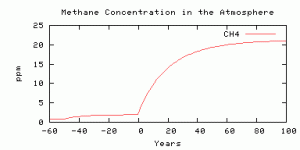
Looks like we got the factor of 10 methane increase about right.
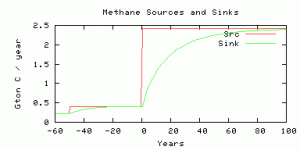
Source and sink of methane in the model.
The lifetime of methane in the atmosphere, used to calculate the methane sink in any time step, is parameterized as a function of concentration following Schmidt and Shindell (2003).
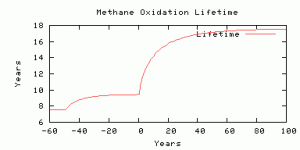
The atmospheric lifetime of methane, used to calculate the sink flux.
The radiative forcing is parameterized from output from the NCAR model, scaled by an efficacy factor of 1.4 from Hansen et al, (2005). The radiative forcing is compared with Business-as-usual CO2 radiative forcing with the model year 0 corresponding roughly to year 2010, and with CO2 rising at 0.65% per year. The methane radiative forcing before year 0 is not time-realistic because the real human sources did not switch on instantaneously 50 years ago, but you can compare the future evolution of radiative forcing from CO2 and methane, from year 0 onwards.
The radiative forcings of CO2 and methane compared. The scenario is more-or-less comparable to 750 ppm CO2, as we thought.
The CO2 concentration used to generate the last figure.
Timing is everything
Four simulations with the same amount of carbon released as methane in the “spike”, on different time scales for the release.
10 Gton C release in 1 year — the spike.
Same spike but not as sharp: 10 Gton over 20 years.
Same 10 Gton but spread over 50 years.
Enjoy. Go and get your swamp gas on, and give the poor model planet your worst. Bwahahahahaha!
References
- G.A. Schmidt, and D.T. Shindell, "Atmospheric composition, radiative forcing, and climate change as a consequence of a massive methane release from gas hydrates", Paleoceanography, vol. 18, 2003. http://dx.doi.org/10.1029/2002PA000757
- J. Hansen, M. Sato, R. Ruedy, L. Nazarenko, A. Lacis, G.A. Schmidt, G. Russell, I. Aleinov, M. Bauer, S. Bauer, N. Bell, B. Cairns, V. Canuto, M. Chandler, Y. Cheng, A. Del Genio, G. Faluvegi, E. Fleming, A. Friend, T. Hall, C. Jackman, M. Kelley, N. Kiang, D. Koch, J. Lean, J. Lerner, K. Lo, S. Menon, R. Miller, P. Minnis, T. Novakov, V. Oinas, J. Perlwitz, J. Perlwitz, D. Rind, A. Romanou, D. Shindell, P. Stone, S. Sun, N. Tausnev, D. Thresher, B. Wielicki, T. Wong, M. Yao, and S. Zhang, "Efficacy of climate forcings", Journal of Geophysical Research: Atmospheres, vol. 110, 2005. http://dx.doi.org/10.1029/2005JD005776
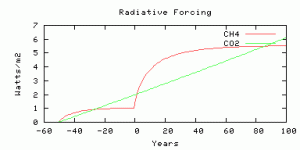
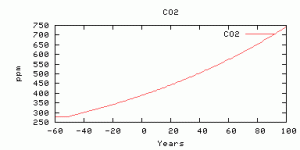
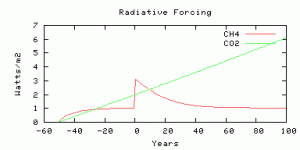
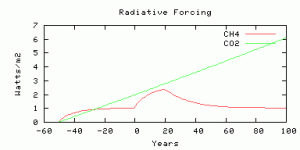
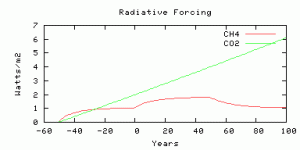
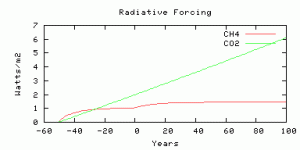
flxible,
In an ideal world, you would have alternatives to fossil fuels–we’ve known they’d be needed since at least the ’60s. However, research has suffered from lack of funding and lack of insight among policy makers.
The dangers of climate change, which we’ve known about since the 80s, ought to have been a spur to research as well. However, denialism and oily money have managed to delay a response by two and a half decades. As a result, I am afraid we will have no choice but to conserve–even to the point of hardship–if we are to buy enough time to find solutions.
The alternative is 1)to run out of critical fossil fuels, and 2)irreparably damage the carrying capacity of the planet even as our human population crests at 9-10 billion people. And that would be ugly.
Mark F 43:
Try running the model with these parameters:
Chronic Methane source flux: 0.2 GT/year
Spike size: 140 Gt
Spike Duration: 100 years.
This results in an increase in [CH_4] of roughly a factor of 7 from about 2 to about 14. The radiative flux contribution from methane increases from about 1W/m^2 to about 4.7W/m^2 which seems in rough accord with the paper you linked to.
I haven’t checked your assertion that a 7 fold increase in [CH_4] corresponds to an increase in the mass of atmospheric CH_4 of about 30Gt but I assume it is correct. To reach a steady value of [CH_4] = 14 ppm requires a significant flux over time so that in fact even though the net change in atmospheric CH_4 is, say, 30GT, to reach that required about 160Gt of CH_4 released into the atmosphere.
[Response:Handy conversion factor that a
gigatonppm of carbon in our atmosphere is pretty close to 2 Gton. So CH4 today is 1.8 ppm, that would be about 3.6 Gton, multiply that by 7 to get close to 30 Gton. Beware mass of carbon versus mass of CH4, however; that’s why chemists prefer mole units. DavidSoot and particulates are not part of the problem? Lack of research? I could almost say Hank and Ray are part of the “denialator conspiracy”. I’ve been walking the walk since the 60’s, the addiction by humanity generally to growth and consumption is, and has been, the problem, not lack of research funding to find a ‘techno-fix’. As I said, methane is not the tipping point, human society and the power of money is the tipping point, and we’ve passed it.
flxible:
Nobody in this conversation is the enemy you believe you are fighting.
Flxible,
Hmm, Can you say where either I or Hank said soot or particulates were not a potential issue? Or where either of us have denied any sort of peer-reviewed evidence?
No? Then, would that be what is known in common parlance as a LIE?
The only thing I can point to that might have triggered such abuse is that I responded to your post. Rest assured that this is the last time I will make that mistake.
Ray Ladbury wrote: “In an ideal world, you would have alternatives to fossil fuels …”
In the real world, we have bountiful alternatives to fossil fuels.
That’s exactly why the fossil fuel corporations have devoted so much effort to obstructing and delaying any effort to transition from fossil fuels to renewable energy.
That’s why their campaign of deceit and denial is built around two “big lies” — first, that the problem does not exist; and second, that the solution does not exist.
Yes Ray, here’s the pointers >
you: “However, research has suffered from lack of funding and lack of insight among policy makers.”
and Hank: “Wood is not fossil fuel.You add no net carbon to the atmosphere; the tree’s carbon came from the atmosphere, and goes back.”
My original post was a response to the quote from Dr. Kevin Anderson about the reticence of scientists: ”…. its very hard to come up and say what you really think, because people don’t want to hear the message.”
“People” have heard the message, and it’s really a question needing an answer. I have no dog in any fight, nor ‘enemies’ in this discussion, on either side of the methane question, but living below a receding glacier, which supplies water and electricity to an area where clear-cut logging is a mainstay and a lot of folks burn wood for heat, I can see both of you as not supplying any more solutions than the denialators who insist that we really need to study things more.
Thanks to Chris R at #40 for a thoughtful response.
“I actually think that we’re seeing the start of Arctic carbon cycle feedbacks in the post 2007 rise of methane. But I am adamant that the science is clear – we don’t know enough to say with certainty how this will all pan out.”
On this we can agree.
“If everyone jumps on the catastrophe bandwagon this will have two negative effects:
1) It will foster a feeling of hopelessness amongst the scientifically uninformed public, leading to the “It’s too late to do anything” attitude.
2) If wrong then in the years to come the denialists will be able to say that AGW has been overstated.”
Here, you presume to know exactly how people will respond to particular a particular statement. I claim no such omiscience and choose to try to find out what is really going on no matter where the line of questioning leads without self-sensoring based on some faulty assumption that I know how others might respond.
Meanwhile, Skeptical Science has an interesting post on the subject (apologies if this has already been linked):
http://www.skepticalscience.com/arctic-methane-outgassing-e-siberian-shelf-part1.html
The conclusion:
“Controversy, however, does not invite complacency. Any increased Arctic methane flux, tapping into vast stores of steadily destabilising methane hydrate, has the potential to keep going over a considerable time-period as a response to warmer (and rising) sea temperatures. We certainly do not need any feedbacks that bring additional natural sources of powerful greenhouse gases to the table, yet that is exactly what we risk up in the Siberian Arctic. The big questions that we now need the answers to are for how long has this outgassing been going on, does it appear to be intensifying and how might a colossal and rapid outburst occur. These are among the points we will be raising with the people on the ground and the answers from our interview with Dr Natalia Shakhova, part two of this post, will soon be appearing, here on Skeptical Science.”
So that’s a place to keep an eye on for perhaps the next clues.
Re 27 December numbers for US crops are at http://usda01.library.cornell.edu/usda/current/CropProd/CropProd-01-12-2012.pdf. However, numbers for China are harder to get, and China is a large producer/ consumer.
Re #30 Ray,
When in the paleoclimate record were the changes in GHG concentrations so rapid? When in the record was the climate system so far out of equilibrium?
An obvious idea would be to try to collect as much of this methane as possible and use it as fuel. If it is going to be released anyway, then it would be better to convert it to CO2 to reduce forcing, while also getting the benefit of its energy, helping to keep existing gas/oil reserves in the ground for longer, and give more time to switch to renewable methods.
Covering vast areas of tundra with polythene sheeting would be a bad idea – it would just make a massive greenhouse and accelerate thawing, and wildlife would not be impressed at all!
If a comprehensive survey of the tundra could be made that could identify significant outgassing from cracks in the permafrost cover, then perhaps they could be covered by domes to capture the methane which is about half as dense as air. Care would need to be taken to purify it out of an explosive mixture. (Perhaps the same technique could be used above cattle sheds?)
We saw clathrates forming in the Deepwater Horizon clean up footage by the robotic subs, and they frustrated the first attempt of covering the blowout preventer with a dome because they blocked the too-small exit drillpipe. However, in shallower shelf waters where methane is outgassing from decomposing clathrate, collecting it should be much easier, though it is probably outgassing from so many places that it would be impossible to collect enough to make a difference, or be economically viable.
I can only speculate without further information from the field.
f, you wrote above:
“… ‘stop burning FF’ is not a solution …. It’s cold right here right now, …I can burn free wood. Pardon me for wanting to eat and stay warm …”
It sounds like you’re having a rough time, and the economy is sitting on many of us retired, or will.
The solution is for us to stop increasing fossil carbon — unnaturally fast — in the atmosphere and oceans, and find wayss to remove the current excess — and to do that, also, unnaturally fast.
90 percent of the big fish are gone.
Almost nobody alive today is old enough to remember how it’s changed.
@60: Also for Ray: (1) When, and under what relevant arctic temperatures, were the permafrost and clathrate carbon deposits formed? (2) Since the deposits formed, have relevant arctic temperatures significantly exceeded formation-time levels? (3) If so, for how long?
re 29 Chris,
When we first saw lakes suddenly drain through the Greenland Ice sheet, folks did not recognize what was going on. Have we looked for such events in shallow Arctic waters? Would we recognize the evidence for such events if we saw it?
I respectfully disagree partially of the methane emission model proposed by Prof.. Archer for the following reasons:
1. The “worst case scenario” that currently exists is the emission of most of methane located at the East Siberian Arctic Shelf, which is already beginning to happen. The potential release of this methane is 1400 Gt. (1400 Billion tons) and not 200 Gton C over 100 years, acording to this model .
This vision not mention the influence of this release to produce higher temperature and the increase at arctic albedo and the consequent release of CH4 and CO2 from permafrost exists at land at Siberia and North America , which is already melting and has a potential for release of 1672 Gt of Carbon.
According Shakhova:
“The total amount of carbon preserved within the ESAS as organic matter and ready to release CH4 from seabed deposits is predicted to be ∼1400 Gt. Release of only a small fraction of this reservoir, which was sealed with impermeable permafrost for thousands of years, would significantly alter the annual CH4 budget and have global implications, because the shallowness of the ESAS allows the majority of CH4 to pass through the water column and escape to the atmosphere.”
Shakhova, N., I. Semiletov, I. Leifer, A. Salyuk, P. Rekant, and D. Kosmach (2010), Geochemical and geophysical evidence of methane release over the East Siberian Arctic Shelf, J. Geophys. Res., 115, C08007, doi:10.1029/2009JC005602.
http://www.agu.org/pubs/crossref/2010/2009JC005602.shtml
According Isaksen:
The atmospheric release of large concentrations of methane can cause an increase in it degradation time to CO2:
“Since reactionCH4 + OH → H2O + CH3 (R1) also represents a significant loss path for OH, additional CH4 emission will suppress OH and thereby increase the CH4 lifetime, implying further increases in atmospheric CH4 concentrations [Isaksen and Hov, 1987; Prather et al., 2001]. This represents a positive chemical feedback, with a feedback factor estimated to be about 1.4 (uncertainty range 1.3 to 1.7) for current atmospheric conditions [Prather et al., 2001]. The nonlinearity in the chemical system could result in a significantly enhanced feedback factor for large CH4 emissions causing large perturbations [Isaksen, 1988].”
Isaksen, I. S. A., M. Gauss, G. Myhre, K. M. Walter Anthony, and C. Ruppel (2011), Strong atmospheric chemistry feedback to climate warming from Arctic methane emissions, Global Biogeochem. Cycles, 25, GB2002, doi:10.1029/2010GB003845
http://www.agu.org/pubs/crossref/2011/2010GB003845.shtml
Also:
“Increased global emissions of methane has caused a 26% decrease in hydroxyl in the atmosphere with t he consequence that methane now persist longer in the atmosphere, before getting transformed into the less potent CO2. This means that concentrated releases of methane, as would occur over the arctic have a far greater GHC potency than IPCC assumption, rising to as much as 120x CO2 over the first 20 years.”
http://www.flipdocs.com/showbook.aspx?ID=10004692_698290
http://www.arctic-methane-emergency-group.org/#/agu-brochure/4558306797
http://www.sciencemag.org/content/326/5953/716.full
And according to ARCTIC-METHANE-EMERGENCY-GROUP,
we are compelled to stabilize Arctic sea ice and Arctic Methane without delay.
http://www.arctic-methane-emergency-group.org
This I agree.
Celso Copstein
> would we recognize the evidence ….?
How’s this look to you? it’s from 2008, a summary to date.
Seems to me that a comparison to the evidence described here would be telling.
If the isotope signature suddenly appears, I’d expect that change will be noticed, as it’s been looked for for quite a while.
http://adsabs.harvard.edu/abs/2008AGUFM.U34A..04W
“… none of the ice datasets published to date support the clathrate gun. Alternatively, we suggest that permafrost and varying onshore thermogenic gas seepages may play a more critical role in the palaeo-atmospheric methane sources and budgets.”
http://onlinelibrary.wiley.com/doi/10.1002/rcm.5290/full
is interesting science; it’s lab tests of the usefulness of the isotope ratios.
Re Andy Lee Robinson “Covering vast areas of tundra with polythene sheeting would be a bad idea ..”
Covering vast areas of potential methane releasing wetlands/peatlands/thawing permafrost etc with Biochar pieces could be a good idea. You could use planes and animal herds to do the job. http://climateforce.net/2012/01/12/geoengineering-potential-biochar-application/
[Response:You might want to think that through a little more.–Jim]
Aaron Lewis, Explain to me why the release of clathrates should depend on the rate of warming rather than the temperature of the ocean depths?
Meow, Are you contending that the clathrate formations are unprecedented? Because if they are not, then certainly we have seen higher temperatures in the oceans without any indication of a clathrate gun.
Look, guys, I freely admit this is worrying–it is the first indication on a large scale of the planet becoming a source rather than a sink of carbon. However, there is nothing in the paleoclimate to indicate a rapid, large-scale, catastrophic release of CH4. There are certainly enough challenges posed by the current situation–not least of which is convincing national governments of the need to take action and that action can be efficacious–without looking for monsters under the bed.
Science must of needs be conservative. It is the only way our voice will remain trustworthy.
SA,
To say we have the solution to a sustainable energy infrastructure at present is rather over optimistic. We have nothing that will work for transport on a large scale. We have no solutions for a reliable grid based on renewables. It does not pay to gloss over the difficulties.
@69 (Ray):
I am not contending anything. I want to learn how much the paleo data tell us about the potential for significant arctic carbon release. Very roughly, has most arctic carbon remained sequestered over long periods under higher relevant temperatures than any we’re likely to see in the near term? What’re the error bars? Has anything changed (e.g., significant additional deposits in vulnerable places) that might suggest a different response than the ones the paleo record documents?
Can you point me to some papers about arctic carbon’s paleohistory?
CAPTCHA: 136. atuolyme
Just been reading about the discovery of previously postulated compounds in the atmosphere called Criegee biradicals. These compounds natually released by plants turn nitrogen and sulfur dioxide into nitrates and sulphate thereby cleaning the atmosphere. Now that we have detected their existance using a synchrotron pure light source we should reasonably soon be able to manipulate these compounds into forms that can be used for climate change mitigation. If we can build a synthetic molecule intermediary that does not require a plant source (because flora on this planet is dwindling rapidly) then in theory we can begin to add this to the growing arsenal of measures we alredy have. Just food for thought!
#64 Aaron Lewis,
Do you have evidence that melt lakes have not been forming and draining in summer on the Greenland ice sheet before observations began? As with Shakhova & Semiletov’s (S&S) observations, and most likely as with the Svalbard clathrates – these processes may well have been going on for milenia. After all in the case of the ESS S&S themselves accept that the beginning of the dissolution process may have started when the ESS was inundated with prior to the holocene, some 10,000 years ago:
In S&S 2010 they coclude:
To Andrew Revkin they said:
From my reading their disagreement with Dmitrenko is flawed. Dmitrenko’s modelling of sub-sea permafrost changes finds that “after 25 years of summer seafloor warming (as observed from 1985 to 2009), the upper boundary of permafrost deepens only by ~1 m.”
#63 Meow,
Jakobsson, 2011, “New insights on Arctic Quaternary climate variability from palaeo-records and numerical modelling”
Figure 2 – 60degN insolation was around 40Watts/m^2 (~10%) greater than the present for well over 2000 years at the start of the holocene (~8k years ago). Text – Drift wood finds and beach ridge formations (no ice-shelves) from the north coast of Greenland and Ellesmere island have been made. This indicates that there were very low summer sea-ice levels during that time. Siberian coastal sea-ice is likely to have been very reduced in summer and may have been lower than the present (due to increased insolation vs today’s forcings).
There is no evidence of substantial methane clathrate decomposition during that time. e.g. Hank’s post #66.
#65 Celso Copstein,
Shakhova et al, 2008, “Anomalies of methane in the atmosphere over the East Siberian shelf: Is there any sign of methane leakage from shallow shelf hydrates?” AGU Conference presentation.
i.e. 50Gton not 1400Gton.
See my reply to Aaron Lewis for a crucial caveat to the 2010 S&S paper.
Isaksen et al & Schmidt/Shindell do not support the quote you make (“…rising to as much as 120x CO2 over the first 20 years”). That quote is from an Arctic Methane Emergency Group report and is referenced “2”, this is a Youtube video by Stephen Chu, it does not support that claim (I’ve just watched it).
For context – IPCC CH4 forcing currently around 0.5 Watts/m^2. Isaksen table 2 gives forcings for direct and indirect effects, from that table and IPCC forcings:
4 X CH4 is a total of 2.2W/m^2 or around 4.4 X current CH4 RF, which is around 1.5 X current CO2 RF.
7 X CH4 is a total of 3.6W/m^2 or around 7.2 X current CH4 RF, which is around 2.4 X current CO2 RF.
13 X CH4 is a total of 5.4W/m^2 or around 10.8 X current CH4 RF, which is around 3.6 X current CO2 RF.
Chris and others, you can read about updated assessment in this SWIPA draft paper, at chapter V http://amap.no/swipa/CombinedDraft.pdf
So let’s feed the models the new numbers as Celso Copstein in #65 suggest and let’s start with preparation (including measures to easy the impacts).
From the draft some other excerpts
[edit copy/paste; you’ve been warned enough]
[Response:You might want to think that through a little more.–Jim]
Please be more specific what exactly you referring to. Use the link context as a basis and then ask me direct questions. Thanks.
[Response:Negative; stay on topic please.–Jim]
RE Chris R “..Isaksen et al & Schmidt/Shindell do not support the quote you make (“…rising to as much as 120x CO2 over the first 20 years”)”
I think what you weres looking for is this:
increases in global methane emissions have caused a 26 percent decrease in hydroxyl and an 11 percent decrease in the number concentration of sulfate particles. Reducing sulfate unmasks methane’s warming by 20 to 40 percent over current estimates http://www.giss.nasa.gov/research/news/20091029/ paper (paywall) http://www.sciencemag.org/content/326/5953/716
Meow and Aaron,
In the early holocene between 8000 and 7000 years ago, there were a couple of 300 year periods where temperatures likely exceeded current levels. Unless it is your contention that the clathrates and permafrost regions did not exist at that time, it is difficult to see how we face immediate danger. There is certainly evidence of a carbon (you can’t tell the difference between CH4 and CO2 in the data) spike in this period, but it was nowhere near 1400 GT of carbon.
Yes, it is a concern–especially in the longer term. It is not an immediate crisis, and the forcing that is increasing that concern is anthropogenic CO2. That is what I mean about it being the big top.
What Shindell is talking about is limiting immediate effects to buy time. It won’t buy enough time.
Ray,
Indeed – we see evidence for these periods in the Welsh mountains, where old peat-diggings reveal bogwood above the current tree-line: I think there are similar examples in the Scottish Highlands.
I reckon we need to look back beyond the Quaternary for any carbon-spike of this nature.
Cheers – John
#77 Prokaryotes,
Nope. I was looking at the papers I stated and the AMEG report. Anyway taking the short-time Global Warming Potential of 72 over 20 years – 72 * 1.4 (i.e. 40% increase) is 98, not 120.
When you link to a 77.3MByte pdf report it’s best to warn people. I gave the section on methane a quick once-over and didn’t see anything new. Celso Copstein didn’t produce new numbers either. So I’m struggling to see what you’re getting at.
Perhaps it would be best if you gave your ‘new numbers’ exlained how your got them and let us see what the model does. With regards a methane pulse it’s only amount and duration of pulse.
Whoah! I backtracked that “120x” quote to the Arctic Methane Emergency Group thing and notice just before that, they state as fact an assumption: turning “methane … into carbon dioxide (CO2) – the comparatively less harmful GHG.”
CO2 is known comparatively more harmful over the long term, not less.
And we haven’t seen any science suggesting their scenario — a sudden burst of methane — is happening.
Again, read the science on the isotope studies, folks. It’ll slow the conversation here down but it will inject some real facts into the opinions.
http://www.giss.nasa.gov/research/news/20091029/397946main_sourcespie_226x172.jpg
(same paper prokaryotes quoted from just above)
is a pie-chart showing the amount from various sources of methane.
THe russians have been studying the permafrost for a long time….
http://permafrost.su/
This analysis is not even close to the worst-case. Worst case would involve the world ocean becoming anoxic due to shut-off of the thermohaline circulation, combined with massive proliferation of methanotrophic organisms leading to a massive out-gassing of hydrogen sulfide. Following these events are atmospheric OH radical depletion and quickly rising levels of methane, setting off the “clathrate gun”.
Let’s look out at a timetable of several thousand years for this to occur…can we rule this out?
Prok @77, the 120x figure is not in that paper, but in the caption to figure two they do mention the 105x value for 20 year methane with feedbacks. Unfortunately, it looks like another example of sloppiness on the part of this group–Hank just pointed out another one.
Chris @ 74 seems to be confused by the admittedly confusing reference system. The actual reference is to an incomplete URL that mentions includes the name Schindell, so still not very helpful.
I am sympathetic with lay people trying to make as much sense of the science as they can, but they should be a bit more careful than this. (And for the record, I am not very sympathetic to their geo-engineering proposals for many reasons, not the least of which is the law of unintended consequences.)
“… reducing black carbon and methane, a key precursor to ozone, fit the criteria best.
… For ozone, we looked at measures like fixing leaky gas pipes, limiting methane emissions from mines, upgrading wastewater treatment systems, and aerating rice paddies.” — http://www.giss.nasa.gov/research/news/20110220/
http://www.picarro.com/community/blog/how_much_methane_escapes_from_leaking_natural_gas_distribution_pipes
“… the country’s natural gas distribution systems were obsolete and made from pipes that are prone to leaks….
… we found numerous leaks, some with concentration levels 15-times higher than the background level for methane in the global atmosphere….”
and
“Recent measurements indicate that urban emissions are a significant source of Methane (CH4) and in fact may be substantially higher than current inventory estimates. As such urban emissions could contribute 7-15% to the global anthropogenic budget of methane.”
—–
Pipeline engineering would be a good idea.
“Plastic natural gas pipe failure data kept secret
by Jaxon Van Derbeken, San Francisco Chronicle
9/26/2011
The type of plastic pipe that caused a natural gas explosion and fire in a Cupertino condominium last month has long been considered a potential threat to the public, but federal pipeline regulators have allowed companies to keep it in the ground and secretly gather limited information about its failings ….
… an especially problematic type of pipe manufactured by DuPont called Aldyl-A. PG&E has 1,231 miles of the early-1970s-vintage pipe in its system.
Federal regulators singled out pre-1973 Aldyl-A starting in 2002 as being at risk of failing because of premature cracking. Explosions caused by failed Aldyl-A and other types of plastic pipe have killed more than 50 people in the United States since 1971 ….”
SecularAnimist says in #56
That’s why their campaign of deceit and denial is built around two “big lies” — first, that the problem does not exist; and second, that the solution does not exist.
That’s perfect! I plan to use that….
David’s inline response in #53:
[Response:Handy conversion factor that a gigaton of carbon in our atmosphere is pretty close to 2 Gton. So CH4 today is 1.8 ppm, that would be about 3.6 Gton, multiply that by 7 to get close to 30 Gton. Beware mass of carbon versus mass of CH4, however; that’s why chemists prefer mole units. David
I’m not parsing that – typo check? Maybe 1 ppm CO2 is 2 Gton Carbon?
Thanks
[Response:Oops, you’re right. I’ll edit the remark above. David]
RE Chris R #80
This model is based on David concluding
“There isn’t some huge bubble of methane waiting to erupt as soon as its roof melts. And so far, the sources of methane from high latitudes are small, relative to the big player, which is wetlands in warmer climes” https://www.realclimate.org/index.php/archives/2012/01/much-ado-about-methane/
“If the number of lakes or their bubbling intensity suddenly increased by a factor of 100, and it persisted this way for 100 years, it would come to about 200 Gton of carbon emission” https://www.realclimate.org/index.php/archives/2012/01/an-arctic-methane-worst-case-scenario/
But the numbers i was pointing to are about 800gt or more from at least partial possible seabed ebullition, as i understand it.
Because most submarine permafrost is relict terrestrial permafrost, the carbon pool held can be estimated from knowledge on current terrestrial carbon storage to include not less than 500 Gt of carbon within a 25 m thick permafrost body (Zimov et al., 2006a), 2 to 65 Gt of CH4 as hydrates (McGuire et al., 2009) together with a significant amount of non-hydrate carbon. […] 800 Gt is previously formed CH4 ready to be suddenly released when appropriate pathways develop. Release of only 1% of this reservoir would more than triple the atmospheric mixing ratio of CH4, probably triggering abrupt climate change, as predicted by modeling results (Archer and Buffett, 2005). http://amap.no/swipa/CombinedDraft.pdf
So, i think that this abrupt events are on a decade scale when the seabed permafrost permeability vanishes from warmer conditions. But David is not considering this at all in his latest blog post. Also new findings about carbon isotopes are not considered too. That’s why i’m looking forward to read Gavin’s take.
Notice, i meant to write permeability rise…
> new findings about carbon isotopes
I’ve been looking; I’ve found papers consistent with what David wrote, e.g.
http://www.agu.org/pubs/crossref/2011/2011GL049319.shtml
http://rsta.royalsocietypublishing.org/content/369/1943/2058.short
http://hol.sagepub.com/content/21/7/1167.short
What new findings about carbon isotopes do you think are not considered?
RE Hank Roberts
Pressurized laboratory experiments show no stable carbon isotope fractionation of methane during gas hydrate dissolution and dissociation
..measured δ13C-CH4 values near gas hydrates are not affected by physical processes, and can thus be interpreted to result from either the gas source or associated microbial processes
http://onlinelibrary.wiley.com/doi/10.1002/rcm.5290/full
Hank #86
I’ve just bought Simultaneously Mitigating Near-Term Climate Change and Improving Human Health and Food Security
I’d read similar stuff it before in Integrated Assessment of Black Carbon and Tropospheric Ozone published early last year.
After bothering UK Government Departments about a Plan B to tackle short term forcing for some time now, I’m pleased that more proper scientists are taking this seriously but this raises two doubts. Firstly, why did it take so long? Secondly, why did they not have the courage to mention changes in diet as a possible mitigation strategy?
For climate see NoBeef.
For food security see It’s the poor that starve.
On a second thought
I think that the short impact methane is about, 50gt at has been estimated, but release over a short time of maybe a decade or less. And this general excepted value should be modeled with extensive scenario analysis. Which should include anthropogenic carbon sequestration potentials (as i mention in comment #65), to get a better understanding what could be done about it.
Then in a second phase microbial processes from different sources (and more hydrate destabilization) make another release (but more gradual over time). When stage 1 is relatively short the second stage will grow over centuries.
Mr. Chris R. writes on the 15th of January, 2012 at 5:22 AM:
Re: insolation and sea ice in the Arctic:
“Jakobsson, 2011, “New insights on Arctic Quaternary climate variability from palaeo-records and numerical modelling”
Figure 2 – 60degN insolation was around 40Watts/m^2 (~10%) greater than the present for well over 2000 years at the start of the holocene (~8k years ago). Text – Drift wood finds and beach ridge formations (no ice-shelves) from the north coast of Greenland and Ellesmere island have been made. This indicates that there were very low summer sea-ice levels during that time. Siberian coastal sea-ice is likely to have been very reduced in summer and may have been lower than the present (due to increased insolation vs today’s forcings).”
I notice that right around 8Ky bp the sea level was several tens of meters lower. What fraction of the East Siberian shelf was not yet submerged then ? I ask because water transports heat much more efficiently than air and unsubmerged ground gets colder than if it were underwater. And does not a greater insolation in summer imply lower insolation in winter, affording greater radiative cooling time in the longer dark ?
sidd
sidd
Re Methane GWP
The 100- year GWP for methane is ~10% greater (~20 to 40%, including AIE) than earlier estimates (5) that neglected interactions between oxidants and aerosols.
http://www.see.ed.ac.uk/~shs/Climate%20change/Data%20sources/Shindell%20methane.pdf
Ah, prokaryotes, that’s the paper I cited earlier in one of the three methane threads. They checked whether the isotope ratios were changed by physical processes and confirmed they were not.
They reason that, therefore, the methane detected they’re discussing is from one of the local sources identified or microbial action, which means the methane is _not _ coming from clathrates.
_If_ they’d shown that the physical processes checked _did_ change the isotope ratios, _then_ the methane _could_ have been from clathrates (altered by those processes).
It hadn’t, so it wasn’t, so it isn’t, from this assessment.
The paper supports the other comments made. That’s not new information. It’s support for the information we have had.
If an amount of, say, 1 Gt of methane from hydrates in the Arctic would abruptly enter the atmosphere, what would be the impact?
Methane’s global warming potential (GWP) depends on many variables, such as methane’s lifetime, which changes with the size of emissions and the location of emissions (hydroxyl depletion already is a big problem in the Arctic atmosphere), the wind, the time of year (when it’s winter, there can be little or no sunshine in the Arctic, so there’s less greenhouse effect), etc. One of the variables is the indirect effect of large emissions and what’s often overlooked is that large emissions will trigger further emissions of methane, thus further extending the lifetime of both the new and the earlier-emitted methane, which can make the methane persist locally for decades.
http://geo-engineering.blogspot.com/2012/01/potential-for-methane-releases-in.html
GEOPHYSICAL RESEARCH LETTERS, VOL. 38, L21803, doi:10.1029/2011GL049319, 2011
http://www.agu.org/pubs/crossref/2011/2011GL049319.shtml
“Looking on the bright side of life”. Layton and Johnstone
Seabed gas find blows all other energy sources out the water